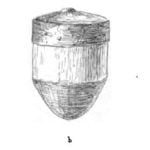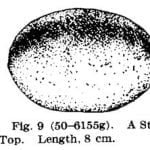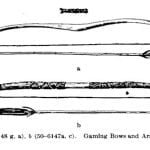
In former times, there was a good deal of merriment in the Blackfoot camps. We have just characterized some of the jokes often perpetrated and may mention others strictly for amusement. One Piegan band was noted for its pranks. One of their favorites was to annoy visitors by a mock family row. The host would begin a quarrel with his wife and then to fight. The neighbors would rush in and with mock indignation take the woman’s part. The result was a general melee in which they took care to fall upon the guest and wallow him about as much as possible without serious injury.
As a rule, jokes were between band and band. Thus it is related that one time a band drove off the horses of another and herded them in the brush near by. Then they innocently offered to join the war party for pursuit. When all was ready they suggested that they look in the brush as the horses might have been overlooked. Again, a band dressed one of their men in white man’s clothes and painted his face black. Then while his confederates were at the camp of the victim band he came up and in plain view caught two horses, going off slowly. The confederates were careful to call attention to it. Some young men pursued but when they were near the man took aim at them. So they hesitated. Finally, the thief disappeared over a hill. Then he whipped up, returned by another route and left the horses in their places again to the confusion of the pursuing party on their return.

Such pranks afforded amusement to all and served to brighten the life of the camps. 1 While there were always a number of persons adept at chaffing and pranks there seems to have been no clown or buffoon, not even in ceremonies. There were, and are now, certain dances that may be termed social in which there are features expressly for amusement, but as these also contain ceremonial features they may be passed by at this writing. Games, on the other hand, seem to have no ceremonial associations and may, therefore, be considered under this head. We shall, however, make a distinction between amusement and gambling. The first are indulged in by children and youths, rarely by adults.
Children had a great many games similar to those of white children, from whom they may have been learned. Among these are tag, hide-and-seek, jumping the rope, stilt-walking, slings, tops, dolls, hobby-horses, coasting, ball games, shooting contests, racing, and follow-the-leader.

The hobby-horse seems to have been peculiar to girls. A stick was selected with a natural bend between two parallel ends. A miniature saddle was sometimes placed in the crook and other trappings added. Girls coasted on pieces of rawhide, squatting at the rear and holding up the front with the hands. In summer, this contrivance was used in sliding down steep hills and cut banks. Boys usually coasted by sitting on a kind of toboggan made of buffalo ribs lashed to cross sticks, though they were not averse to using the more comfortable rawhide sheet. 2 Small boys often played at owning, stealing and tending horses, using rude images of mud or selected stones of appropriate form. When buffalo were represented, their foot-bones were usually used. The buzzer of bone and the bull roarer were known as children’s toys, but the winged bones of the Teton and the snow snake were not recognized by our informants. A toy called “whizzing bone,” has not been identified by us, but was described as a contrivance for throwing. Some of our informants had seen the cup-and-ball, but rarely among their own people.
Top was a favorite game for boys. The wooden top (Fig. 8) is usually made of birch in the round and varies in length from 11 to 16 cm., in diameter from 8 to 12 cm. The bark is removed entire or in sections and the heads marked with nails or paint, partly for ornamentation and partly for identification. The wood must be well seasoned so as not to be heavy. The whips have four buckskin lashes about 35 cm. in length and handles about 75 cm. long. This game is played in soft snow, the object i being to determine who can drive his top over the greatest distance without interrupting the spinning. The usual stakes are buckskin whip strings and tops.
Another top game is played upon smooth ice. The tops are water-worn egg-shaped pebbles {Fig, 9) about 15 cm, in transverse diameter. The whips are similar to the preceding except that bark strings are used as shown in Fig. 10. This is a matter of economy since it is the belief that the rocks and the ice wear out buckskin strings very quickly and while the bark strings are also short lived they are easily replaced. In the game, the rocks are set spinning by whipping and when at high speed are driven together, the one that stops spinning first loses. In this game, the players are in pairs.
Sometimes these rock tops are used on hard snow. A shallow trench is dug which the tops must cross while spinning. A skillful player will whip his top in such a way that it will jump the trench. However, should it fail it may be whipped out or thrown out by the hand; if it ceases to spin, the player loses. The name for top games is approximately, ” knocking it.”
Another boy’s game is with balls of mud stuck on the ends of willow rods about two meters long. A swing of the rod will drive off such a ball with great force. If such play becomes a contest, the aim is to see who can throw the greatest distance.

There are a number of arrow games. The collections contain two sets. One bow (Fig. 1 lb) has a peculiar decoration on the back, produced by cutting away portions of the bark. The other bow (Fig. 11a) is of similar form but plain. The arrows are in seta of six, of plain feathered shafts, about 75 cm. long and slightly sharpened. One arrow with the carved bow has a peculiar head (Fig. 11b). There are also two grass targets as in Fig. 11a.
One simple game is opened by a player an arrow into a bank of earth which in turn becomes the target for all. The one placing an arrow nearest the target arrow wins all the arrows shot in the round. In a more complicated game one arrow is set up beside a bank and used as a target as in the preceding. The boy making the best shot gathers up all the arrows at the target and shoots them at the grass target (Fig. 11). Each arrow striking this target is his, otherwise they revert to their owners. The grass target must be held in the hand grasping the belly of the bow and the arrow. By a swing of the arms it is tossed forward and upward and must be hit while in the air to win. 3
Another game spoken of as the sliding arrows was in favor. No bow was used, the so-called arrows being but straight slender sticks about 80 cm. long, neither sharpened nor feathered. The set in the collection contains 39 sticks, 28 of which are plain, 4 burned black at one end and 7 decorated with a spiral burned band. We have no information as to the significance of these divisions. In the game the players take an equal number of sticks. They are thrown by hand, poising them on a small heap of earth. The player throwing the greatest distance takes all the sticks thrown. As in other games, the play continues until one has all the sticks. The casting of wooden darts, or arrows, is another boys’ game of the same general type. The set of darts in the collection contains twelve willow sticks about a meter long and 1.8 cm. in diameter. Each stick is sharpened at one end and split into quarters at the other. Fig. 12. These darts are usually decorated and to some are attached tufts of horsehair.

In the game the darts are thrown from the hand. First one is cast into a clump of bushes and the players in turn cast at it as a target. The last throw wins the darts. The use of the hair tufts was explained as an aid to the count; thus, if several darts fell about equally near the target dart, the one whose hair tuft touched it was declared the winner.
We secured vague accounts of another game in which arrows were shot at a bundle of arrows, the best shot taking the bundle.

The wheel game is played with a netted hoop, strictly for amusement, by young people. The hoop in the collection is shown in Fig. 13.1 The center mesh is called the navel and the open parts of the loops around the hoop, the teeth. The darts are simple pointed sticks about 80 cm. long without forks at the end as observed among some other tribes. Counts are made when the darts pierce the navel or one of the teeth, according to any value agreed ujwn by the players. Two persons are necessary to the game, but there is no maximum limit to the number of players. The opposing sides take up positions at fifty yards or more. A player rolls the wheel toward the opposite side, its players casting darts at it as it passes. Should a count be made the wheel is thrown back high in the air. the opposing side attempting to catch it on their darts. Should they in turn make a count, the wheel is thrown back to the other side, etc. For every failure to count, the wheel is returned by rolling. 4

A kind of shinny, called “batting ours,” was played by men, women and youths. Bats of rough sticks with slightly curved ends were used (Fig. 14). The balls are spherical, about the size of a base ball, composed of skin covers stuffed with hair. The game is rough and frequently results in serious injuries. The players are arrayed in two sides. Two lines, or goals, are placed about 300 yards apart. The players group about the midway point and the game is opened by tossing the ball into the air. Each side strives to bat the ball over its own goal.
Another ball game, known as the Cree Women, is played by adults and youths. A ball is used similar to the preceding, but is tossed from hand to hand. The players are in pairs. The game is opened by tossing the ball into the air whence each player strives to recover it. The one who secures it, then faces his partner and the ball is tossed back and forth. The other players may use every means to disconcert them except actual physical interference. When the ball is dropped all rush for it and the first to secure it, plays with his partner as before.
Wrestling was common among boys and young men. Formal bouts were usually between two sides. The players sat facing in rows. One side put forward a man with a challenge to the other. They put forward an opponent. The victor was then the next challenger until thrown.
A rough game, known as kicking each other, was popular among young men and boys; the usual way was to form two opposing lines and kick each other to see which would give way. Another game, known as bear play, was popular when swimming; boys would unite, seize a boy and toss him into the deepest water, then scamper away. The victim pursued until a boy was caught when, at once, the others joined in tossing him into the water.
A children’s game, known as skunk, is a kind of round in which all stand in line each with hands on the shoulders of his neighbor. The leader carries a stick of wood, burning at the end, from which he beats sparks with another stick. The row of children sing and dance without breaking the line. The leader endeavors to come near the rear of the line so that the sparks will fly upon the players, they in turn seek to avoid him without breaking away. While this was a rough game, it was popular.
Boys often amused themselves by placing embers from the fire on a stone and striking them with another stone. When skillfully done, this gives off a report like a gun.
Citations:
- For a sketch of the social amusements in Blackfoot camps, see Grinnell, George Bird. Blackfoot Lodge Tales. New York, 1904, p. 185.[
]
- Maximillian says of the Mandan that children glided down heaps of snow “on a board, or piece of the backbone of a buffalo, with some of the ribs attached to it.” 445.[
]
- Culin, Stewart. Games of the North American Indians. (Twenty-fourth Annual Report, Bureau of American Ethnology, Washington, 1907), Fig. 505, 391.[
]
- An unusual form of this wheel is shown by Culin (Culin, Stewart. Games of the North American Indians. (Twenty-fourth Annual Report, Bureau of American Ethnology, Washington, 1907), p. 447.[
]
